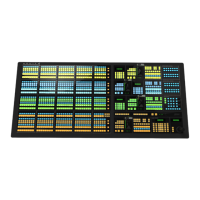7. Press Size/Soft Border to apply a border to the
edge of the wipe transition.
• Border — adjust the size of the border (0 turns
border off).
• Softness — adjust the softness of the border
or edge of the pattern. If there is no border
applied, the softness is applied to the edges if the
pattern.
Tip: You can apply a color or a wash to the border. Press
Border Matte and follow the instructions in Washes on
page 103 or Mattes on page 104.
8. Press H-Mult or V-Mult to apply horizontal or
vertical multiplication to the pattern. Press the button
multiple times to apply up to 5 times multiplication.
9. Press Aspect to turn the aspect ratio on and use the
Aspect knob to adjust the aspect ratio of the border.
10. Press Rotation and toggle Rotation on to apply a
rotation to the pattern.
• Continuous Rotation — apply a continuous
rotation to the pattern. Use the Speed knob to
select the rate at which the pattern continuously
rotates. Selecting a positive value rotates the
pattern clockwise, and selecting a negative value
rotates the pattern counter-clockwise.
• Transition Rotation — apply a xed number
of rotations to the pattern as the wipe is
transitioning. The speed of the rotation depends
on the number of the amount of rotation and the
rate of the transition. Use the Rotation knob to
select the amount of rotation of the pattern that
occurs during a transition. Selecting a positive
value rotates the pattern clockwise, and selecting
a negative value rotates the pattern
counter-clockwise.
• User-Controlled Rotation — apply a xed
amount of rotation to the patter. Use the
Degrees knob to adjust the rotation of the
pattern.
11. Press UP ONE.
12. Press Matrix Tile Size to adjust the size of the tiles
in a matrix pattern. If a matrix pattern was not used
for the wipe, skip this step.
• Square — use square tiles in the matrix.
• Tall — use tiles that are taller than wide in the
matrix
• Wide — use tiles that are wider then tall in the
matrix
• Size — select the number of tiles that are used
in the matrix. The available selection depend on
the selected shape of the tiles.
13. Press UP ONE.
14. Press Wipe Modulation and toggle Modulation
on to apply wipe modulation to the pattern.
15. Press Animation to animate the ripples (On).
Tip: Turning animation off freezes the ripple animation.
16. Press Vertical Params to adjust the ripples to the
left and right of the pattern or Horizontal Params
to adjust the ripples to the top and bottom of the
pattern.
• Amplitude — adjust the height of the ripples
in the selected directions.
• Wavelength — adjust the width of the ripples
in the selected directions.
• Rate — adjust the speed that the ripples move
in the selected directions.
DVE Wipes
A DVE wipe is based on a sequence that uses a
combination of ying keys and effects to transition
between video signals. For a Background transition, the
video signal on the Background bus is replaced by the
video signal on the Preset bus according to the sequence.
Only after the transition has completed do the crosspoint
selection ip-op between the buses.
DVE wipes can either be created from sequences, or you
can use one of the pre-created sequences and wipes
provided with your switcher software. The sequences
and wipes are pre-installed when you purchase a new
switcher.
To load new sequences unto your switcher, you must
copy the wipes from the CD to a USB ash drive and
then recall the sequences on your switcher.
The sequence is selected either through the Pattern
Selection Menu, or by entering the sequence number on
the keypad.
Keep the following in mind:
Keep the following in mind when working with DVE
wipes:
• The switcher dynamically allocates DVE channels
to produce the wipe effect. If there are not enough
channels available, a dissolve is performed instead.
• There is a single frame of delay at the start of DVE
transitions.
To Set Up a DVE Transition
1. Press DVE on the Transition module.
42 • Transition — Acuity Operation Manual (v9.2)

